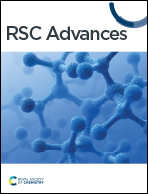Low-temperature electrolytes based on linear carboxylic ester co-solvents for SiOx/graphite composite anodes†
Abstract
Silicon-based anode materials have been applied in lithium-ion batteries with high energy density. However, developing electrolytes that can meet the specific requirements of these batteries at low temperatures still remains a challenge. Herein, we report the effect of linear carboxylic ester ethyl propionate (EP), as the co-solvent in a carbonate-based electrolyte, on SiOx/graphite (SiOC) composite anodes. Using electrolytes with EP, the anode provides better electrochemical performance at both low temperatures and ambient temperature, showing a capacity of 680.31 mA h g−1 at −50 °C and 0.1C (63.66% retention relative to that at 25 °C), and a capacity retention of 97.02% after 100 cycles at 25 °C and 0.5C. Within the EP-containing electrolyte, SiOC‖LiCoO2 full cells also exhibit superior cycling stability at −20 °C for 200 cycles. These substantial improvements of the EP co-solvent at low temperatures are probably due to its involvement to form a solid electrolyte interphase with high integrity and facile transport kinetics in electrochemical processes.



 Please wait while we load your content...
Please wait while we load your content...